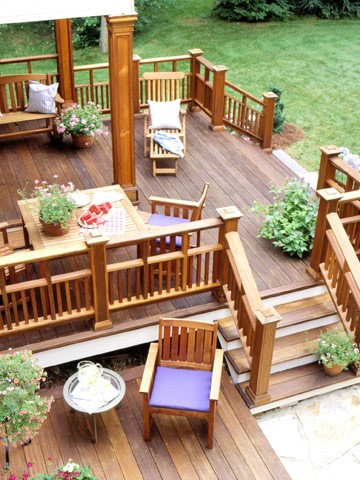Adding a deck to your house can make it easier to enjoy your outdoor space in nice weather. It can also boost your home’s value by adding curb appeal — making your home more attractive if you decide to sell.
Although a home with a deck can support a higher list price, building one can cost tens of thousands of dollars. It’s possible, however, to assemble a simple deck for less, depending on the materials, labor, and time required. Before jumping into a deck construction project, here are seven factors you should consider.
1. Your budget
Before you start any project, it’s smart to determine how much you can spend. Whether you’re building the deck on your own or enlisting the help of professionals, setting a budget can prevent you from overspending.
If you’re taking the DIY route, you’ll want to price out different materials and tools from various stores. If you’re hiring a company, call around to a few places to get quotes until you find the right fit.
Once you have a number in mind, determine how flexible your budget is in case problems arise that cost extra money. If you don’t have flex room, you’ll know ahead of time if you need to compromise to come in under budget.
2. The location of the deck
You need to figure out the dimensions of the deck and where it will connect to your house. This will ensure you have adequate room in your yard. Think about which areas of your yard get the most sun or shade. You might prefer the deck in a cooler area where your family can enjoy eating outside. You should also consider your family’s privacy. The right spot for a deck might be where it’s shielded by trees or a fence.
3. Your foundation
When you know where you want to place your deck, you’ll want to assess your foundation to ensure it’s level before you start building. It’s important not to skip this step or you might end up with a tilted deck.
The footings — which will help support your deck — are generally set by adding posts into a hole and pouring concrete below the soil line. To ensure your footings will fully support your deck, make sure your foundation is sturdy and doesn’t shift.
4. The materials
There are plenty of different materials to choose from when building your deck. Pressure-treated wood is usually the most affordable option. You might also opt for traditional hardwood or softwood, which requires more maintenance to sand, stain, and treat, but may save you some money upfront.
Other materials, such as composite, can be more durable in the face of weather and general wear and tear. Yet composite doesn’t have the same appearance as real wood.
If your deck is near a pool or an area with a lot of moisture, a PVC deck might make sense because it’s more water resistant than other materials. You might pay more for a PVC deck, but it’s easier to take care of.
If you think you’ll sell your home in the near future, consider choosing a material that’s long lasting so your deck will still look new when you list your property.
5. Your deck’s style
The shape and style of your deck is another aspect to consider before you get to work. Consider if you need to add railings and the style of the rail. You’ll want to factor this into your budget. If you want a rounded deck, you’ll also need to account for different wood cuts. Lastly, consider if you’ll need stairs for a two-tiered deck or to lower your deck to ground level.
6. Built-ins for storage or seating
Many custom decks have built-in options for storing outdoor supplies, pillows, or children’s toys. Built-ins may also function as dining benches, tables, or extra seating. A built-in may cost more, but it can make your deck look more seamless and intentional. Determine if a built-in is important to your design before getting started.
7. Lighting
Lastly, think about how you’ll light your new space once it’s built. Will you use string lights that you can plug into an existing outlet, or will you need lighting hardwired to your house? If you have deck stairs, you might want to light the pathway so no one trips at night. You may also want overhead or motion-sensored lighting incorporated into your design.
It’s a good idea to talk to an electrician so he or she can look over your design and determine the best and safest way to implement your deck lighting. You’ll want to make sure all electrical work is fully up to code and can pass an inspection, especially if you’re planning to sell your home in the future.
Tips for Preparing Your Deck for Winter Weather


